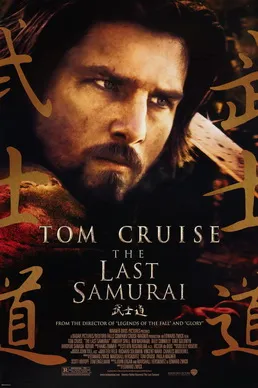Historical accuracy of The Last Samurai

Historical accuracy of The Last Samurai

Characters
Captain Nathan Algren
Algren is fictional, though loosely inspired by Western advisors in Japan like Jules Brunet. His specific backstory, capture, and integration with samurai rebels are invented for the plot.
Katsumoto Moritsugu
Primarily based on Saigō Takamori, leader of the Satsuma Rebellion. However, Katsumoto's specific personality, relationship with Algren, and some actions are fictionalized.
Emperor Meiji
The real Emperor during Japan's modernization. The film portrays him as younger and more easily manipulated than historical accounts suggest; his direct interactions are fictionalized.
Mr. Omura
Likely inspired by figures like Ōkubo Toshimichi or Omura Masujirō, but Omura Masujirō died years before the Satsuma Rebellion. The character is a villainous composite representing modernization's negative aspects.
Simon Graham
A fictional character serving as narrator and observer, representing Western documentation of Meiji Japan.
Colonel Bagley
A fictional antagonist representing Algren's past trauma and negative aspects of Western military attitudes.
More characters
Taka
A fictional character created to facilitate Algren's cultural immersion, personal redemption, and provide a romantic subplot.
Nobutada
A fictional character representing the younger generation of samurai and acting as a plot device (e.g., in the rescue scene).
Ujio
A fictional archetype representing the disciplined, traditional samurai warrior initially distrustful of Algren.
Story
US veteran hired to train Imperial Japanese Army
Westerners (mostly European) did train the IJA, but Algren's specific role, background, and combat against samurai are fictional.
Samurai rebellion against Meiji government
The film's central conflict is based on the Satsuma Rebellion of 1877, led by Saigō Takamori against the modernizing Meiji government.
Algren captured and lives with samurai
This core plot element is fictional; no historical basis for a captured Western advisor integrating with Saigō Takamori's rebels.
Samurai forbidden to wear swords
The Haitōrei Edict of 1876 banned sword-wearing for samurai, stripping them of a key status symbol and contributing to unrest like the Satsuma Rebellion.
Final battle: Samurai vs. modern army
The Battle of Shiroyama saw samurai with traditional weapons (and some guns) making a last stand against the well-equipped Imperial Army, but the film dramatizes specifics and Algren's role.
Katsumoto commits seppuku aided by Algren
Saigō Takamori died at Shiroyama; he was likely mortally wounded and then beheaded by a follower (a form of assisted suicide/preserving honor). Algren's involvement is fiction.
Ninja attack on Katsumoto's village
There is no historical record of ninja assassins being employed by the Meiji government against Saigō Takamori or his followers during the Satsuma Rebellion.
Algren influences Emperor Meiji after battle
The final scene where Algren meets the Emperor and influences policy by presenting Katsumoto's sword is entirely fictional.
Rapid Westernization and industrialization of Japan
The Meiji era was indeed a period of intense and rapid modernization across Japanese society, military, industry, and politics, accurately reflected as the film's backdrop.
Emperor Meiji easily swayed by advisors
While Emperor Meiji relied on advisors, he was a more complex and influential figure than the film's portrayal of him as easily manipulated suggests.
Romanticization of the samurai cause
The film portrays the samurai rebels primarily as noble victims of progress, downplaying the complexities of the samurai class and the practical/economic reasons behind the rebellion.
Algren's PTSD from Native American conflicts
While Algren is fictional, his trauma reflects historical realities of the brutal Indian Wars and the psychological toll on soldiers, providing character motivation.
Foreign powers seeking influence and trade
The Meiji era saw significant pressure and involvement from Western nations (USA, UK, France, Germany, etc.) seeking trade advantages and political influence in Japan.
Samurai rescue Katsumoto from Tokyo
This dramatic rescue sequence involving Algren and Katsumoto's son is entirely fictional; Saigō was never captured and held in Tokyo during the rebellion.
Setting
Meiji Era Japan (c. 1876-1877)
The film is accurately set during the crucial Meiji period, focusing on the time leading up to and including the Satsuma Rebellion.
Visual Contrast: Old vs. New Japan
The production design effectively contrasts traditional Japanese villages/architecture with the rapidly Westernizing cities and introduction of modern technology.
Samurai Armor and Clothing
The traditional samurai attire, including armor (yoroi), kimono, and hakama, is generally well-researched and visually accurate for the period depicted.
Imperial Army Uniforms
The Western-style uniforms adopted by the Meiji government's Imperial Japanese Army reflect the military modernization efforts of the time.
Weaponry Clash: Swords vs. Guns
Accurately portrays the technological disparity central to the conflict: traditional samurai weapons against modern rifles, cannons, and Gatling guns.
Samurai Mountain Village
While reflecting the rural base of the Satsuma domain, the specific village is fictional and potentially romanticized in its idyllic portrayal.
Language Use (English/Japanese)
The ease with which characters communicate across languages is unrealistic but a common cinematic necessity. Algren wouldn't learn Japanese so quickly.
Introduction of Railways
Japan began constructing railways during the Meiji era as part of its modernization drive; Omura's association with them reflects this development.
Presence of Westerners (Traders, Advisors)
Meiji Japan saw an influx of Western diplomats, traders, engineers, and military advisors, making the presence of characters like Graham and Bagley plausible.
Overall Atmosphere of Change and Conflict
The film successfully captures the turbulent atmosphere of the Meiji Restoration, marked by cultural clashes, rapid change, and violent conflict.
